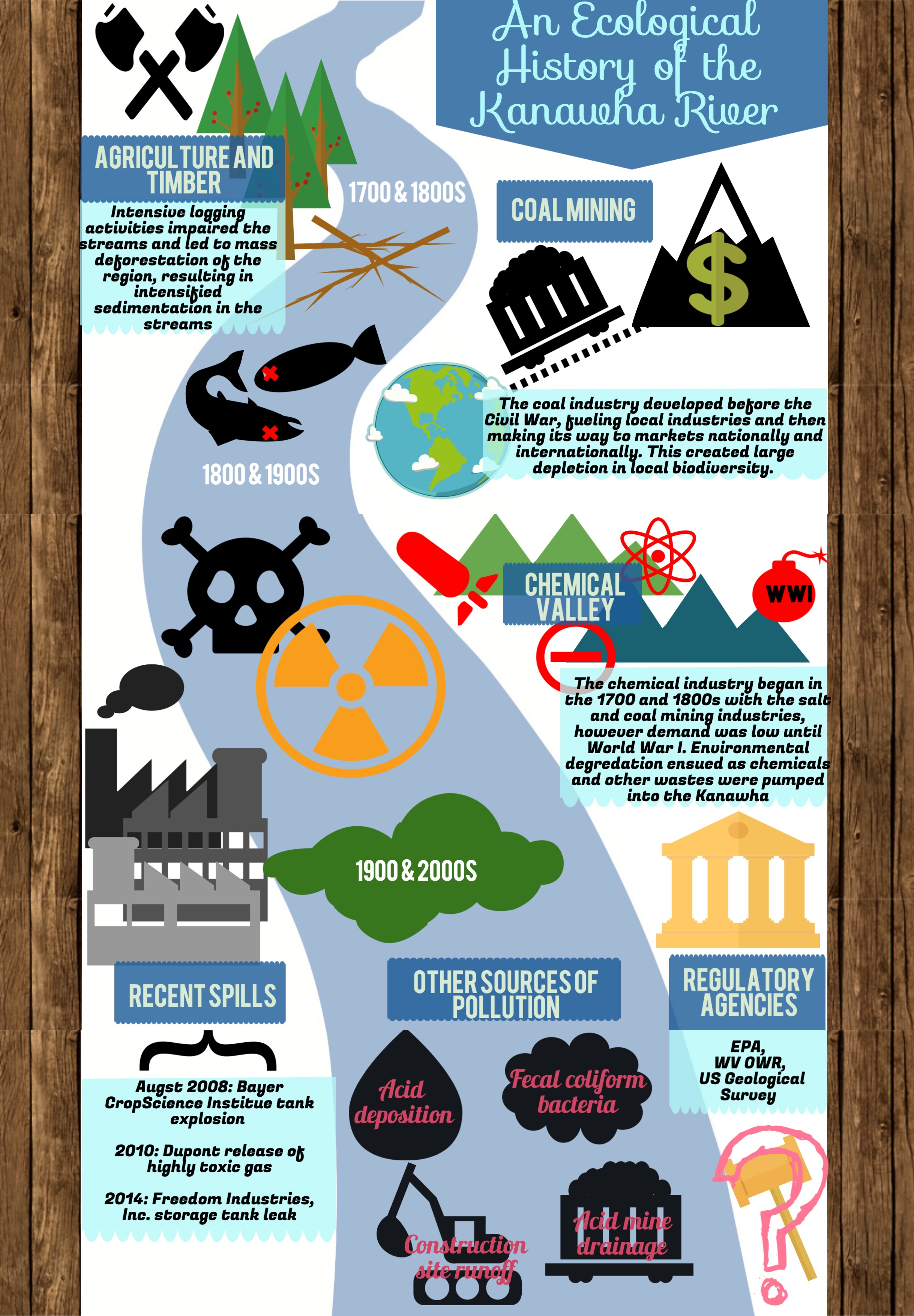 The Kanawha River is divided up into an Upper and a Lower section. The lower includes the mainstem Kanawha River downstream from the Elk River, as well as all of the tributaries of the section. The Upper Kanawha River extends from the confluence of the Gauley River and the New River northwest to the confluence of the Upper Kanawha and the Elk Rivers. Before the twentieth century, the Lower Kanawha River was primarily a region for agriculture and timber. As of January 1998, at least 67 National Pollutant Discharge Elimination Systems (NPDES) were permitted within the watershed, 23 of which were sewage treatment plants and 44 were industrial discharges. After a 1998 ecological assessment of the watershed, West Virginia’s Division of Environmental Protection suggested a series of recommendations to both restore highly degraded streams and preserve the high quality streams of the area. The study found streambank degradation, increased erosion and sedimentation, as well as pollution from failing septic tanks and improper disposal of sewage or gray water (Watershed Assessment Program, 1997). However, due to the low chemical impacts of the surrounding watershed, the Lower Kanawha has had less overall degradation as compared to the Upper.
The Kanawha River is divided up into an Upper and a Lower section. The lower includes the mainstem Kanawha River downstream from the Elk River, as well as all of the tributaries of the section. The Upper Kanawha River extends from the confluence of the Gauley River and the New River northwest to the confluence of the Upper Kanawha and the Elk Rivers. Before the twentieth century, the Lower Kanawha River was primarily a region for agriculture and timber. As of January 1998, at least 67 National Pollutant Discharge Elimination Systems (NPDES) were permitted within the watershed, 23 of which were sewage treatment plants and 44 were industrial discharges. After a 1998 ecological assessment of the watershed, West Virginia’s Division of Environmental Protection suggested a series of recommendations to both restore highly degraded streams and preserve the high quality streams of the area. The study found streambank degradation, increased erosion and sedimentation, as well as pollution from failing septic tanks and improper disposal of sewage or gray water (Watershed Assessment Program, 1997). However, due to the low chemical impacts of the surrounding watershed, the Lower Kanawha has had less overall degradation as compared to the Upper.
The Kanawha Valley is an alluvial valley created during periods of glaciation created a huge reservoir, depositing alluvial material over thousands of years. The ice shelf eventually retreated, leaving the Kanawha River and its tributaries in the ancient alluvial lakebed. Salt was one of the main attractions to the Upper Kanawha Valley when the coal industry was just beginning. By the mid 1800s, much of the forests were cleared to meet the increasing charcoal demand used to fuel salt furnaces and for pasture to feed livestock. During this time of intensive agriculture and logging activities, sedimentation impaired the streams. Once the farms were abandoned, however, the forests grew back and sedimentation decreased. Coal extraction from the Upper Kanawha streams began before the Civil War, initially used to replace the depleted forests as a fuel in the local salt industry. Later, the coal began fueling steam engines and making steel in industrial markets worldwide, largely thanks to the proximity of the Chesapeake and Ohio Railroad running parallel to the river. Before coal mining began, evidence suggests healthy levels of biodiversity in the Kanawha River and tributary streams. At one time, freshwater mussels and other fish scattered the rivers, supporting the local populations substantially. Today, however, the tributaries do not have any signs of mussels, and the recovering fisheries only vaguely represent the thriving river that the Kanawha once was (West Virginia Division, 1999).
The chemical history of the Kanawha Valley dates back to the early days of salt mining. What is now known as the “Chemical Valley” began at Gauley Bridge in central West Virginia, where the New River and the Gauley River flow into the Kanawha. While the chemical industry began in the late 1700s with the introduction of salt and coal miners, demand was relatively small until World War I. Then, demand for explosives and other chemical products skyrocketed, bringing business to the region (Parker, 2014). Environmental degradation resulted from industrial development as large volumes of chemical wastes and other pollutants were discharged into the Kanawha River. Improvements to environmental quality began around 1960 as different programs were implemented. Though much progress was made, several environmental problems still persisted. The National Enforcement Investigations Center (NEIC) conducted a study of the Kanawha Valley in 1984 which examined many of the issues still at hand (National Enforcement Investigations Center, 1984).
References:
National Enforcement Investigations Center. (1984). Overview of Environmental Pollution. Denver, Colorado.
Parker, L. (2014, January 16). A Century of Controversy, Accidents in West Virginia’s Chemical Valley in Lead-up to Spill. National Geographic. Retrieved from http://news.nationalgeographic.com/news/2014/01/140116-chemical-valley-west-virginia-chemical-spill-coal/#close-modal .
Watershed Assessment Program, Office of Water Resources, West Virginia Division of Environmental Protection. (1997). An Ecological Assessment of the Lower Kanawha River Watershed. Charleston, West Virginia.
West Virginia Division of Environmental Protection Office of Water Resources. (1999) An Ecological Assessment of the Upper Kanawha River Watershed. Charleston, West Virginia.
